Please help the NWS spread these important safety messages on social media! Everyone is welcome to use the text and images provided below to help the NWS build a #WeatherReady Nation. #WeatherReady Wednesday is a National Weather Service initiative to help spread weather safety messages each week. Each week you can pick a different topic to share. It can be based on the current weather or you can share one about weather that you don’t see in your area too often but others might if they are traveling.
Facebook
It’s Weather-Ready Wednesday! Time to get prepared! Don’t let bad weather sneak up on you! Get in the habit of checking checking weather.gov every morning before you go out. Make sure that you are ready for whatever the day may bring.
Twitter
It’s #WeatherReady Wednesday! Don’t let bad weather sneak up on you! Get in the habit of checking weather.gov every morning before you go out.

Facebook
It’s Weather-Ready Wednesday! During a drought, be vigilant. Conserve water by taking shorter showers and not washing your car. Practice fire prevention by properly disposing of cigarette butts and not setting off fireworks. Follow any additional directions from local officials. For more information about drought safety, visit weather.gov/drought
Twitter
It’s #WeatherReady Wednesday! During a drought, conserve water, practice fire prevention and follow directions from local officials. weather.gov/drought

Facebook
It's Weather-Ready Wednesday! When your hometown is suffering from drought conditions, do you know what to do? Visit the National Weather Service Drought Safety page to find out how you can help! weather.gov/drought
Twitter
It's #WeatherReady Wednesday! Visit the NWS Drought Safety page to find tips for areas in drought! weather.gov/drought

Facebook
It’s Weather-Ready Wednesday! We apologize in advance for this jingle getting stuck in your head, but we’d do anything to help you remember to Turn Around, Don’t Drown. youtu.be/5JUsYrjg6xU
Twitter
It’s #WeatherReady Wednesday! We apologize in advance for this jingle getting stuck in your head, but we’d do anything to help you remember to Turn Around, Don’t Drown. youtu.be/5JUsYrjg6xU #TurnAroundDontDrown
Facebook
This Weather-Ready Wednesday, don’t underestimate the power of water. It only takes 6 inches of fast-moving water to knock over and carry away an adult, and 12 inches to carry away a small car. Turn Around Don’t Drown! weather.gov/safety/flood-turn-around-dont-drown
Twitter
This #WeatherReady Wednesday, don’t underestimate the power of water. It only takes 6 inches of fast-moving water to knock over and carry away an adult, and 12 inches to carry away a small car. Turn Around Don’t Drown! weather.gov/safety/flood-turn-around-dont-drown

Facebook
It’s Weather-Ready Wednesday! Slowing down is the most important thing you can do to drive safely in dense fog. Reduced visibilities can lead to motor vehicle accidents. Visibility is usually the lowest on bridges and near bodies of water. Learn more about fog safety by visiting weather.gov/fog.
Twitter
It’s #WeatherReady Wednesday! Fog can be extremely dense on bridges over water. Please slow down when driving in dense fog. weather.gov/fog

Facebook
This Weather-Ready Wednesday, remember that driving in fog can be dangerous. Be on the lookout for sudden changes in visibility. The patchy nature of fog can lower visibility quickly especially if you are driving fast, so be sure to slow down. Visibility may also be lower near rivers. weather.gov/safety/fog
Twitter
It's #WeatherReady Wednesday! The patchy nature of #fog can lower visibility quickly—slow down and stay alert! weather.gov/safety/fog

Facebook
It’s Weather-Ready Wednesday! It’s still hurricane season. Find out how you can prepare and know your evacuation zone. weather.gov/safety/hurricane
Twitter
It’s #WeatherReady Wednesday! Are you prepared for hurricane season? Visit weather.gov/safety/hurricane #HurricanePrep #ItOnlyTakesOne

Facebook
Do you live in a hurricane evacuation zone? If so, you need to plan on where you and your family would go if you are told to evacuate. This Weather-Ready Wednesday, learn what to do with FEMA’s Evacuation Guidelines, and know your evacuation route! Visit ready.gov/evacuating-yourself-and-your-family
Twitter
This #WeatherReady Wednesday, plan where your family would ride out the storm if told to evacuate! ready.gov/evacuating-yourself-and-your-family #HurricanePrep
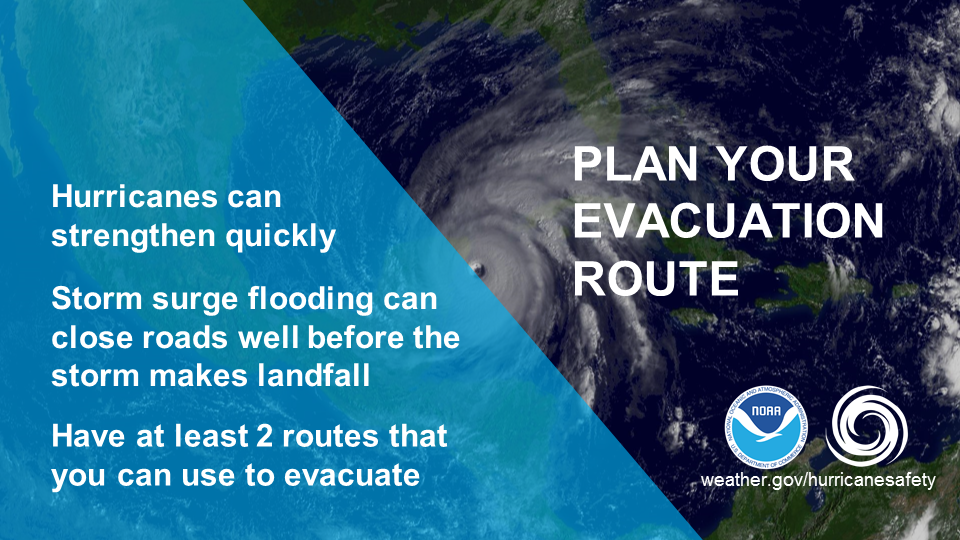
Facebook
It’s Weather-Ready Wednesday! Solar flares are huge explosions of electromagnetic radiation from the Sun lasting from minutes to hours. They are seen as enhancements in optical and extreme ultraviolet/x-ray wavelengths; and can be detected as bursts of noise in radio wavelengths. Solar flares occur in a large range of strengths, have emissions that travel at the speed of light, and reach Earth in eight minutes. They can cause radio blackouts on the sunlit side of the Earth. To learn about radio blackouts, visit swpc.noaa.gov/phenomena/solar-flares-radio-blackouts.
Twitter
It’s #WeatherReady Wednesday! Solar flares are energetic explosions from the Sun & can cause radio blackouts from minutes to hours. swpc.noaa.gov/phenomena/solar-flares-radio-blackouts
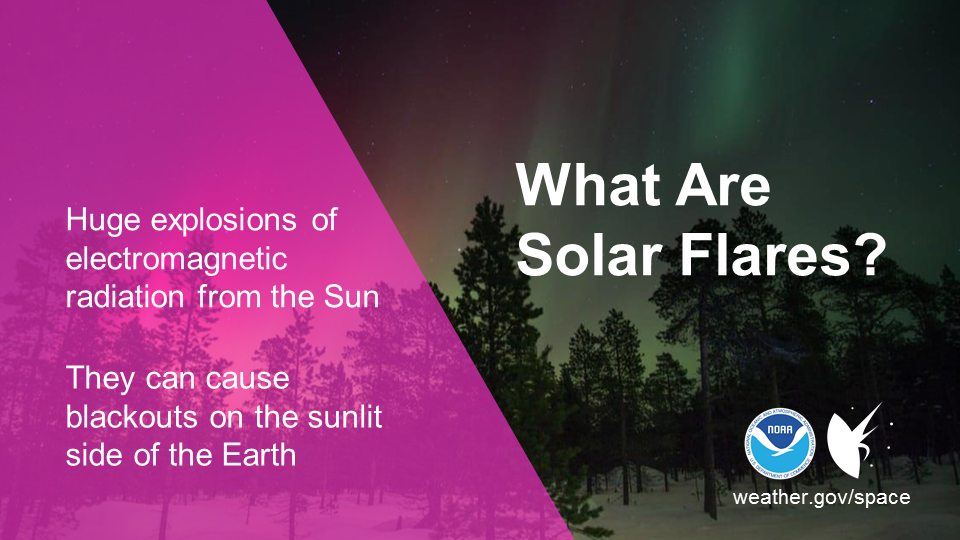
Facebook
It’s Weather-Ready Wednesday! Although the Earth’s magnetosphere, ionosphere, and atmosphere do a great job protecting us from hazardous space weather, it is still possible for space weather to cause power outages. Find out more about #SpaceWeather impacts at swpc.noaa.gov/impacts/electric-power-transmission.
Twitter
It’s #WeatherReady Wednesday! The Sun is the main source of #SpaceWeather, & it could even cause power outages! Find out more at swpc.noaa.gov/impacts/electric-power-transmission

Facebook
It’s Weather-Ready Wednesday! A tsunami can be very dangerous to life and property on the coast. It can produce strong and dangerous currents, rapidly flood the land, and cause great destruction. Even small tsunamis can be dangerous. Strong currents can injure and drown swimmers and damage and destroy boats in harbors. weather.gov/tsunamisafety
Twitter
It’s #WeatherReady Wednesday! A #tsunami, which may resemble a fast-rising flood, can be very dangerous to life & property. weather.gov/tsunamisafety
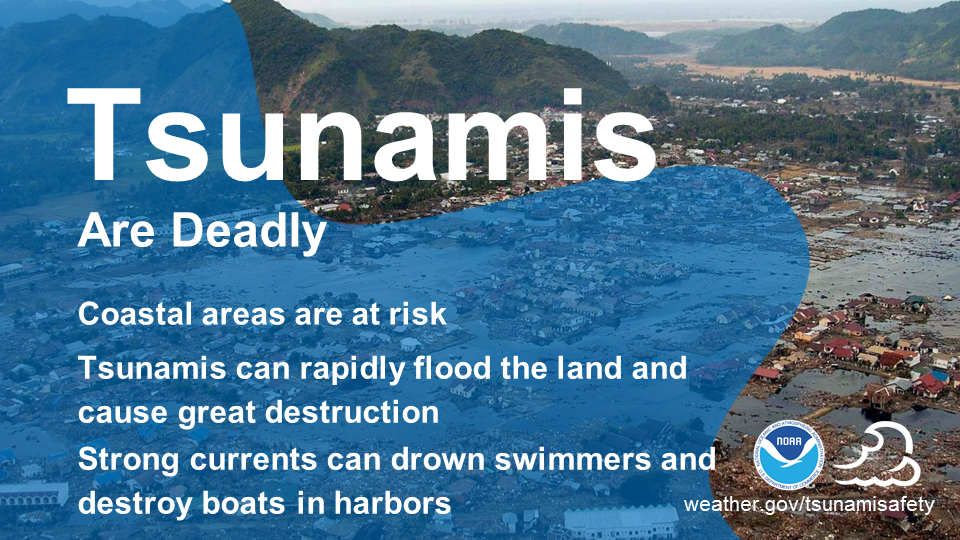
Facebook
It’s Weather-Ready Wednesday! In the event of a tsunami, some tsunami warnings will be official, others will be natural. Both are equally important. Official tsunami warnings will tell you what to do. Get updates from local radio/tv or your mobile phone. Follow instructions from local officials. weather.gov/safety/tsunami-during
Twitter
It’s #WeatherReady Wednesday! Both official & natural #tsunami warnings are important. Learn how to respond: weather.gov/safety/tsunami-during
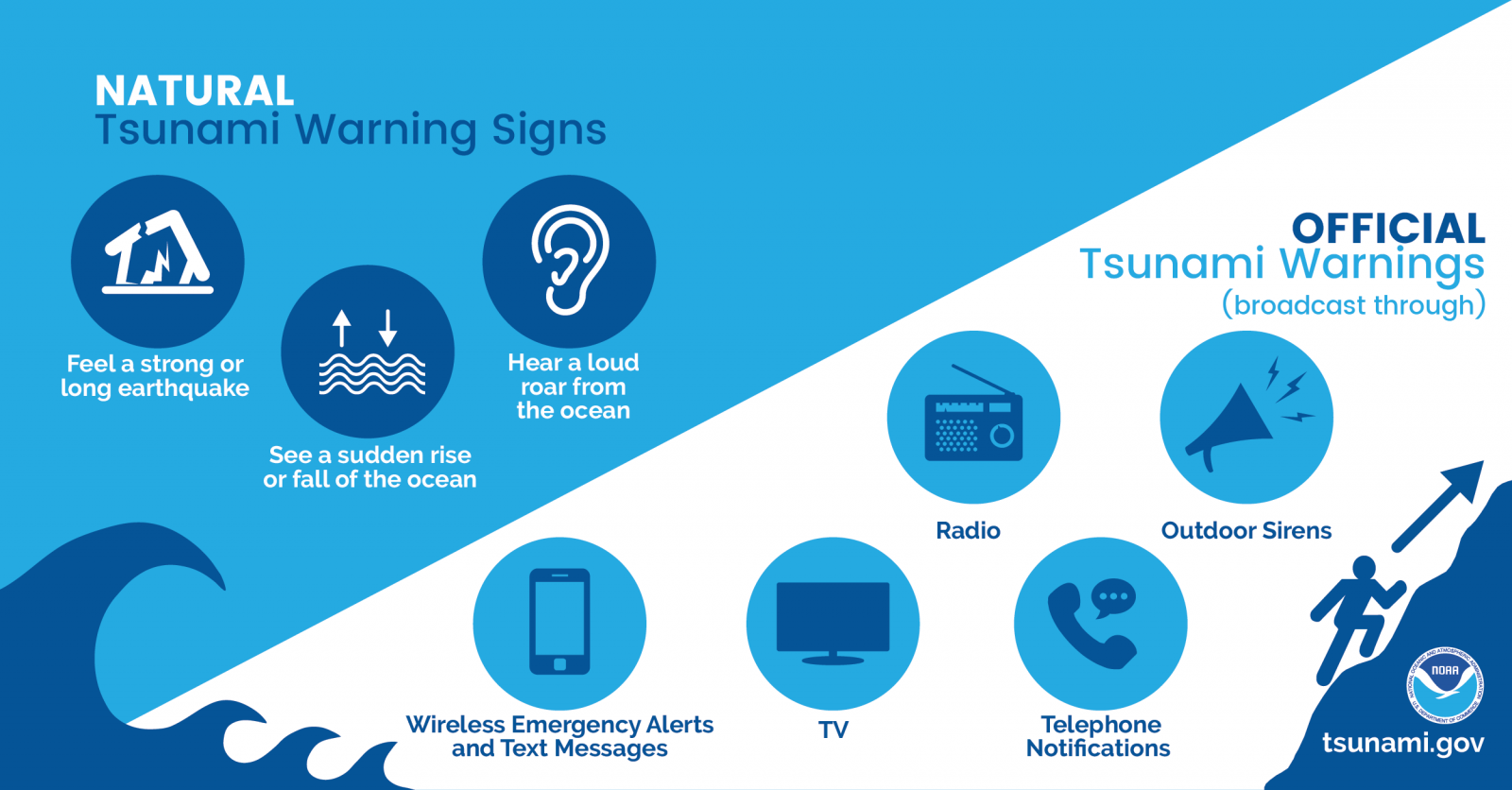
Facebook
This Weather-Ready Wednesday, be aware that high winds can make driving dangerous. If driving during windy conditions, slow down and keep two hands on the wheel, avoid large trucks and trailers, and be aware for downed tree branches and power lines. Bridges and overpasses can be particularly dangerous to drive over when it is extremely windy so choose routes to avoid them. weather.gov/safety/wind-during
Twitter
It's #WeatherReady Wednesday! When windy: slow down, keep two hands on the wheel, avoid large trucks, powerlines & trees. weather.gov/safety/wind-during

Facebook
It's Weather-Ready Wednesday! Even the most common items become a dangerous objects when picked up and carried by the wind! When a High Wind Watch or a Severe Thunderstorm Watch is issued, secure outdoor items such as patio furniture, sports equipment and trash cans. Remove dead tree branches near your home before the next strong storm system blows through. weather.gov/safety/wind-during
Twitter
It's #WeatherReady Wednesday! Even the most common items become a dangerous objects when picked up and carried by the wind. weather.gov/safety/wind-during
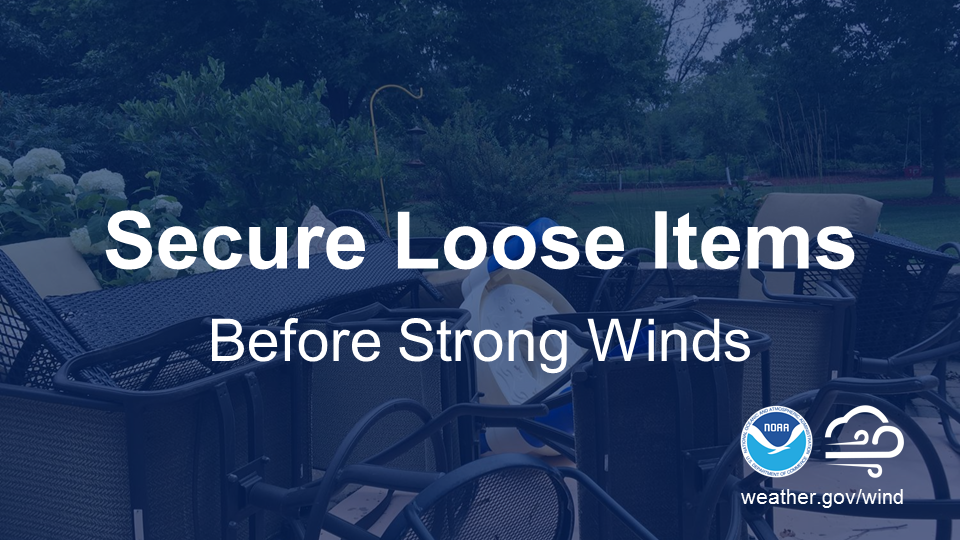
Facebook
This Weather-Ready Wednesday, be aware of the health risks of wildfire smoke, as it can harm you in multiple ways. Smoke can hurt your eyes, irritate your respiratory system, and worsen chronic heart and lung diseases. Learn how you can protect your health and be safe if you are exposed to wildfire smoke. cdc.gov/disasters/wildfires/index.html
Twitter
This #WeatherReady Wednesday, learn how to protect yourself from wildfire smoke. cdc.gov/disasters/wildfires/index.html
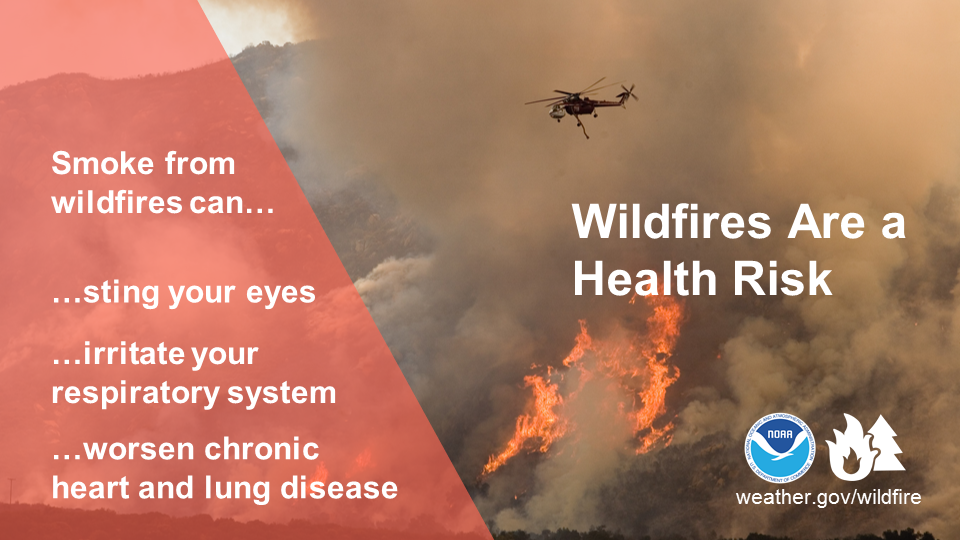
Facebook
It’s Weather-Ready Wednesday! During a wildfire, dust masks aren’t enough! They won’t protect you from the fine particles in wildfire smoke. It is best to stay indoors, keeping windows and doors closed. If you’re running an air conditioner, keep the fresh-air intake closed and the filter clean to prevent outdoor smoke from getting inside. airnow.gov/index.cfm?action=smoke.index
Twitter
This #WeatherReady Wednesday, remember that dust masks aren’t enough to protect you from the wildfire smoke particles. airnow.gov/index.cfm?action=smoke.index
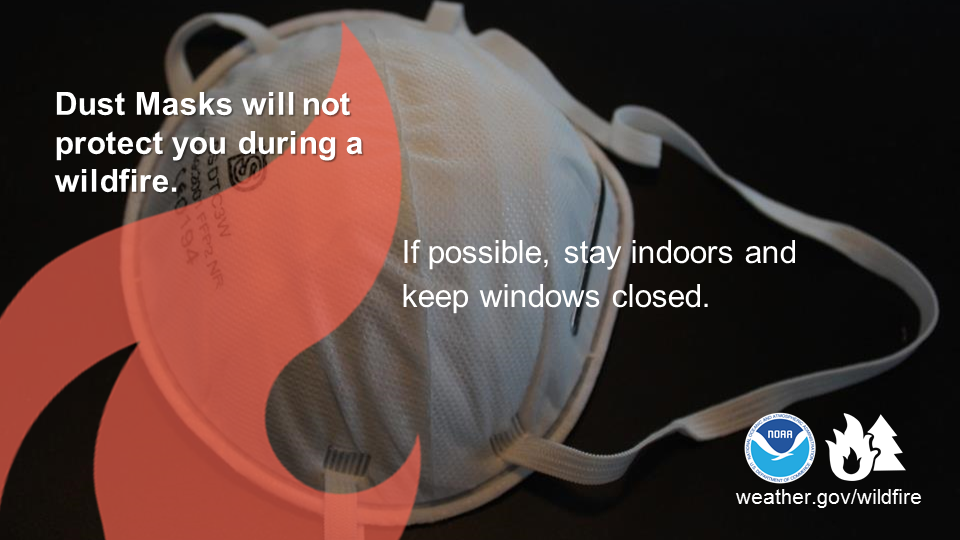
Facebook
It’s Weather-Ready Wednesday! Winter driving can be hazardous. One simple way to keep yourself and everyone on the road safe is to slow down. Remember, “Ice and snow, take it slow”. Learn more at weather.gov/winter
Twitter
It’s #WeatherReady Wednesday! Do your part to keep everyone safe on the roads this winter. Learn more at weather.gov/winter

Facebook
It's Weather-Ready Wednesday! You love your pets, so keep them warm, dry, and well-fed this winter. weather.gov/winter
Twitter
It's #WeatherReady Wednesday! You love your pets, so keep them warm, dry, and well-fed this winter. weather.gov/winter
